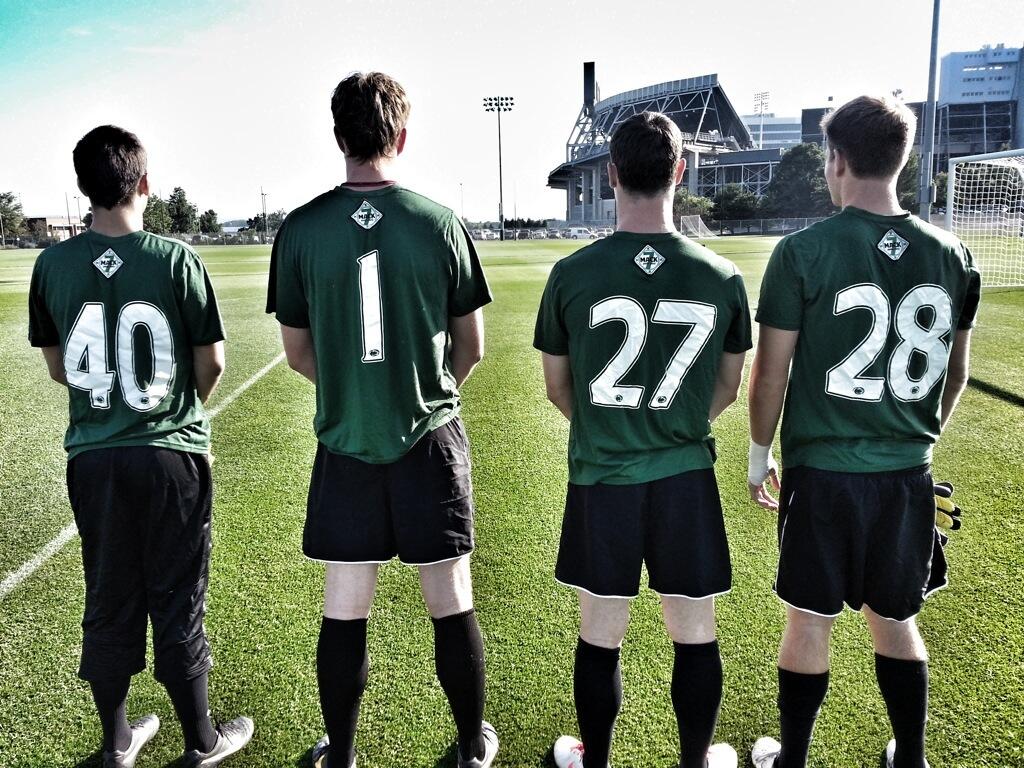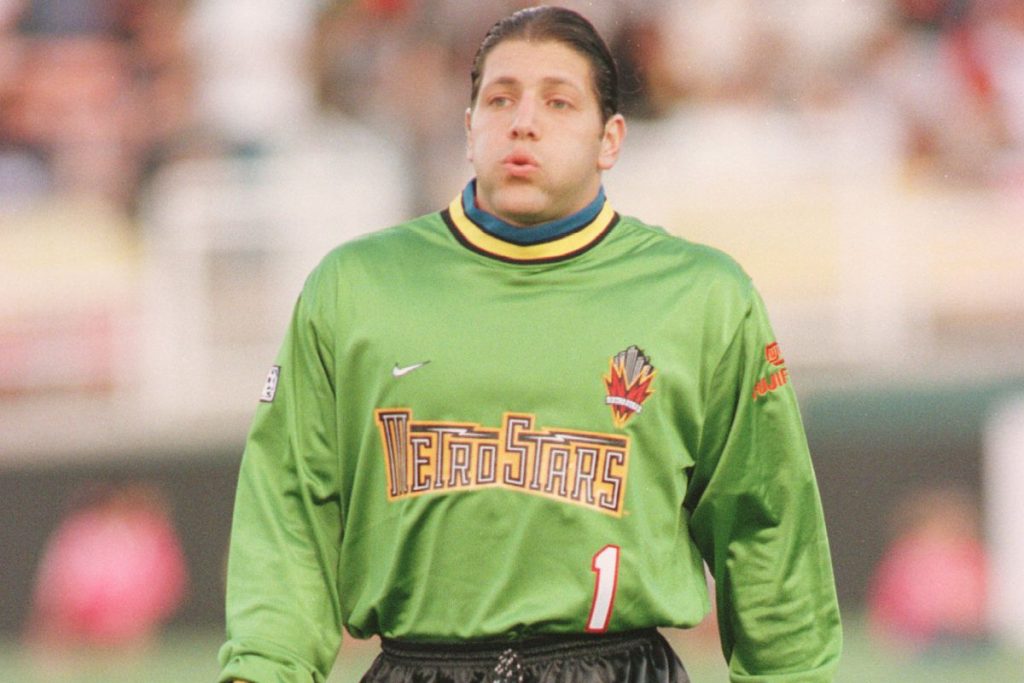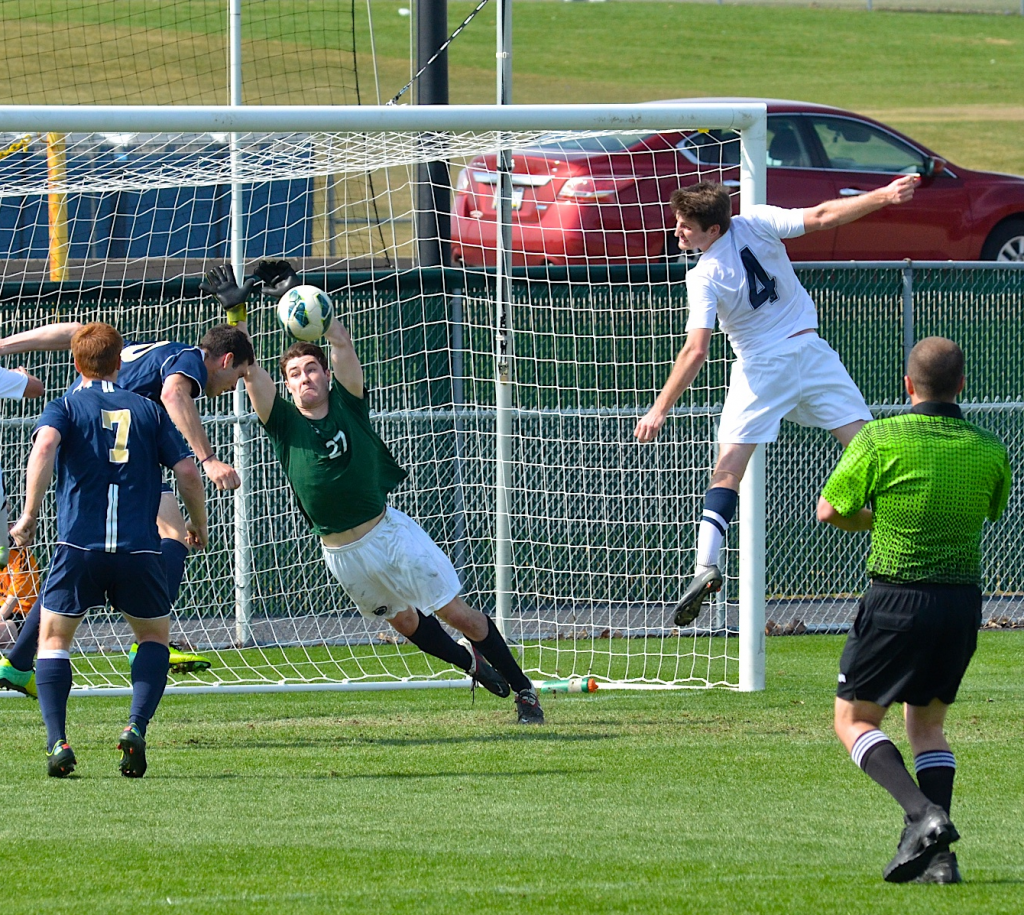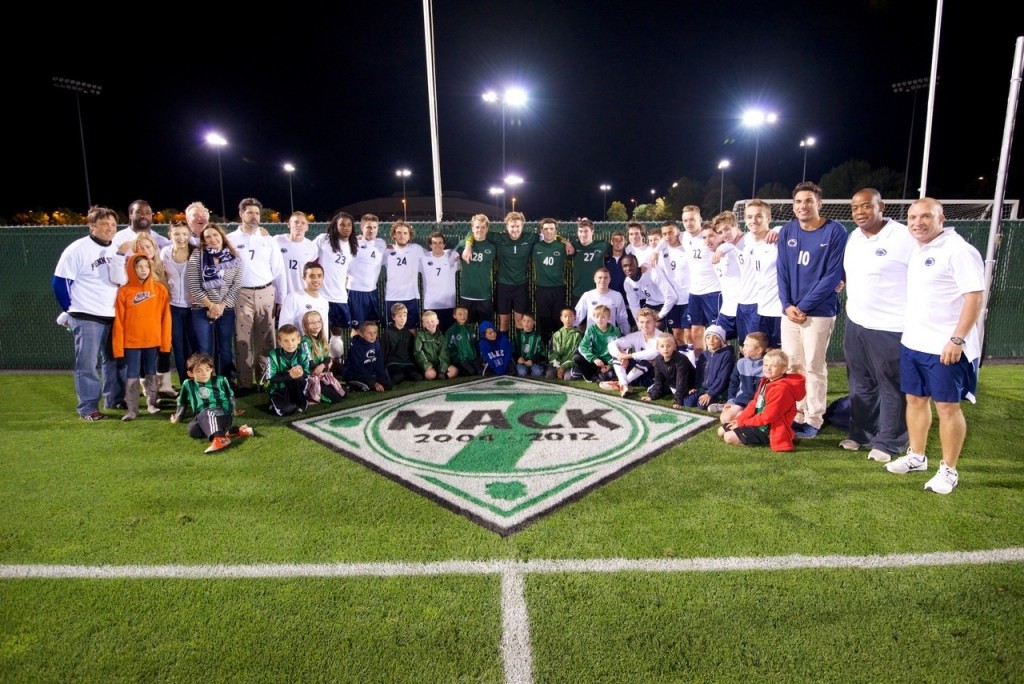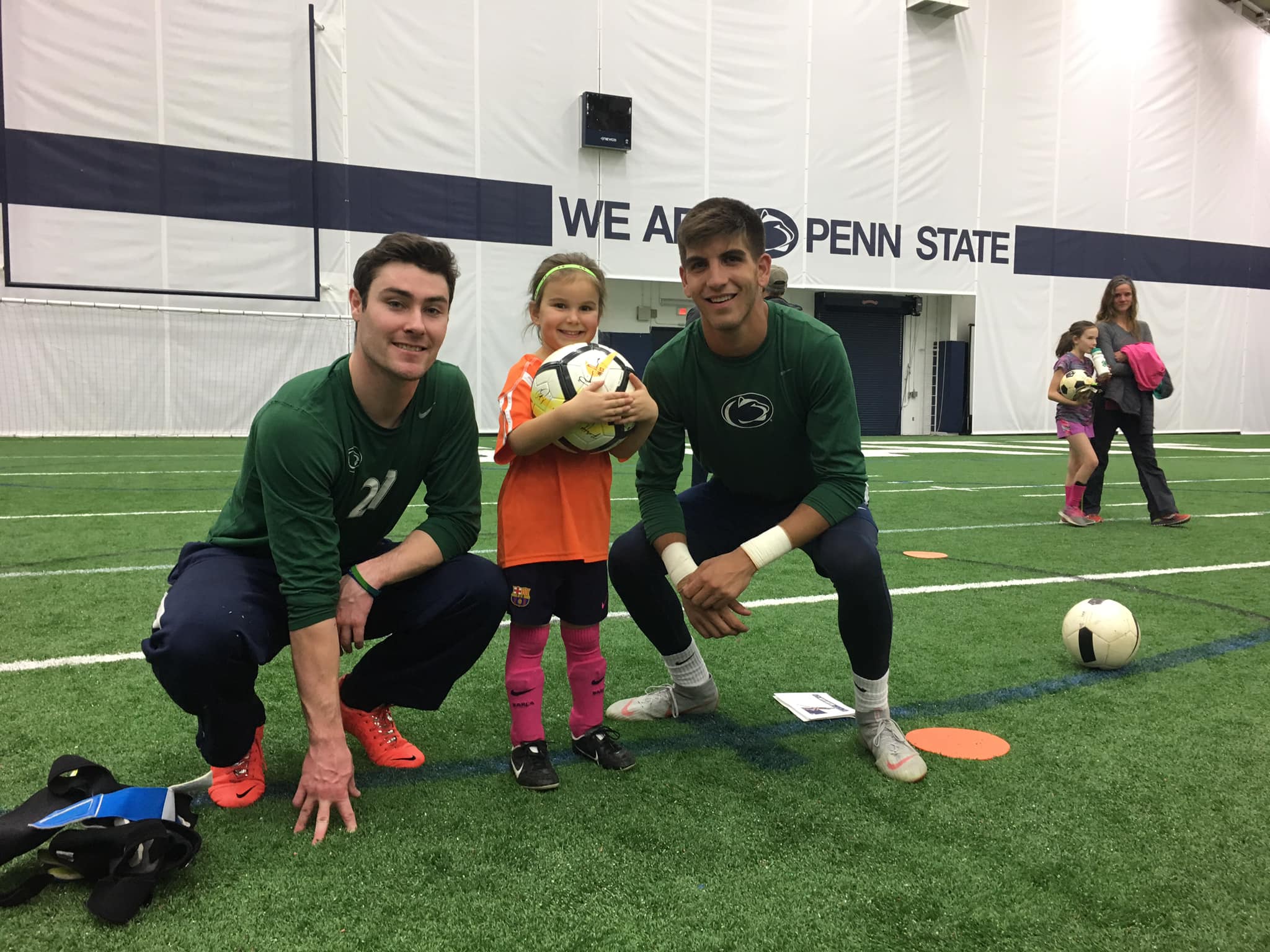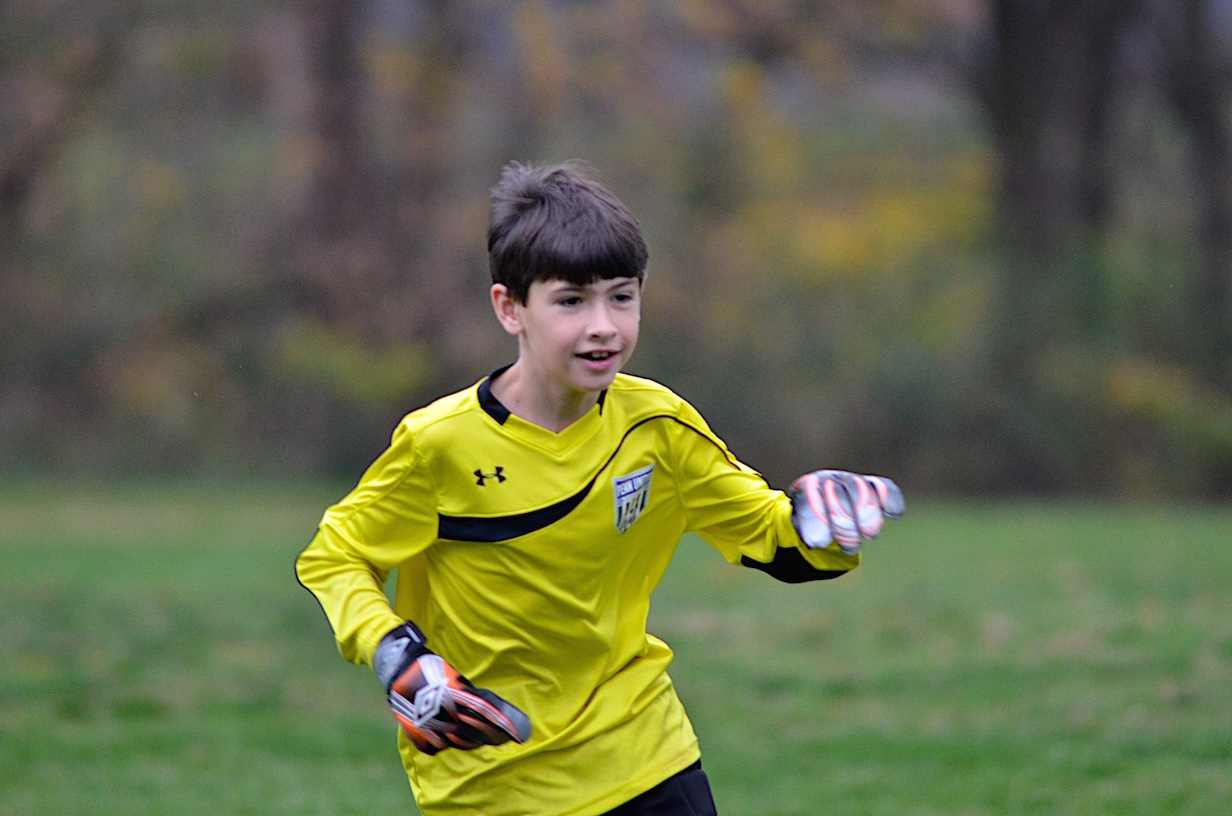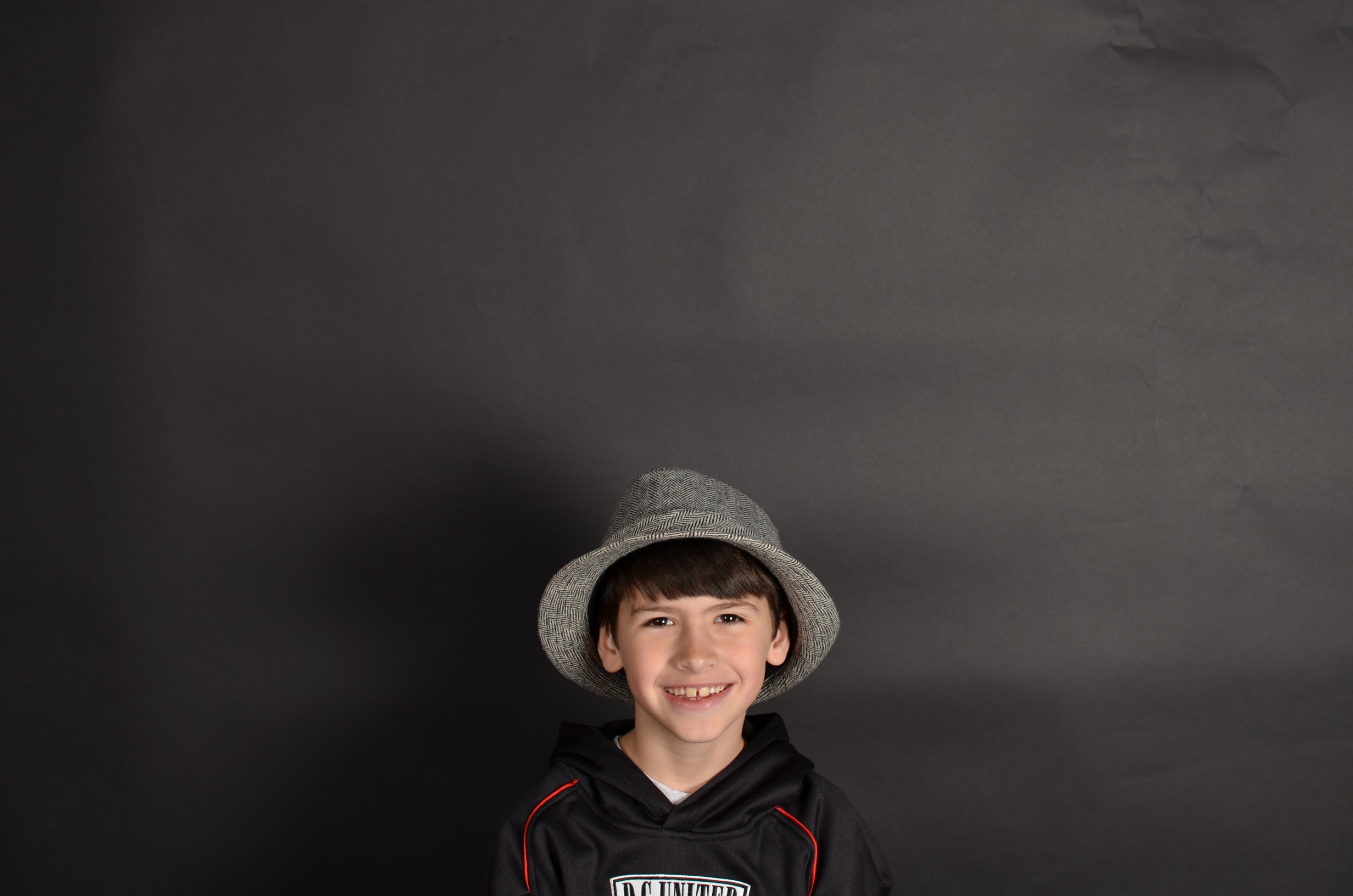The essay below is by Penn State alumnus and former goalkeeper Dan Sheerin. His son Danny was one of the first Mack Brady goalkeepers at Penn State and their entire family has been a mainstay at the annual Mack Match and Winter Clinic. He and I were musing on the fact that Mack’s team was the Celtics and that so often, keepers wear green. As usual, this gifted writer and poet took this germ of a thought and brought it to flower. Thank you Dan! -Cb
Green has for ages been the most prominent and popular jersey color for those who play soccer’s goalkeeper (GK) position. This is an account of how long ago the tradition of the keepers’ ubiquitous “wearing of the green” jerseys came to be. It’s also an account about a boy who was proud to pull on a green GK jersey, a great young goalkeeper named Mack Brady — who tragically passed away due to a blood infection when he was just eight years old, shortly before his ninth birthday. Yet Mack’s commitment to being a GK, and his plan to play as a goalkeeper for Penn State one day, lives on in many meaningful, memorable, marvelous ways. Along those lines, in addition this is a story about how today the tradition of GKs donning jerseys of green, as well as Mack’s goalkeeper and Penn State dream, continue to inspire a powerful legacy, heartfelt memories, and foster great dedication and motivation for past and present Nittany Lion goalkeepers, and indeed for the entire PSU soccer family.
Goalkeepers and the Wearing of the Green
During the early 1900s, the game of soccer and its rules were for the first time being diligently standardized and formalized in Europe, and particularly in England. Indeed, England was where the game is understood to have originated centuries earlier, albeit in a far more unstructured, unregulated, and fairly unrecognizable fashion when compared to today’s game. Yet with the start of the 20th century, the UK’s recently established International Football Association Board, made up of representatives from England, Northern Ireland, Scotland, and Wales, was active in establishing and codifying formal, consistent rules of the game. And one of the rules put in place was that GKs would be required to wear different color jerseys from the rest of their team. This was, of course, for the purpose of indicating that GKs were unique in that they are the only players on the field whose hands could be used to handle the ball while it is in play. Further, GKs could only use their hands while operating within the lined patch of the field known as penalty box area.
More specifically regarding the rule that GKs must wearing different colored jerseys from the rest of their team, as the “Goalkeeper Are Different” website (a source providing an encyclopedic compilation of GK facts and feature stories) reports:
“Goalkeepers in particular, until the rules were relaxed in the 1970s, were limited to green, blue, scarlet and white tops — except for international matches, where yellow or black was the color of choice — following a ruling by the International Football Association Board (IFAB) in 1921. Green proved the most popular (jersey color for goalkeepers) simply because of the law of averages, as very few teams (field players) wore a green football kit.”
From my personal experience, as a once burgeoning American teenage soccer player, GK, and soccer fan in the 1970s, the only soccer I and other soccer aficionados of that era got to see on television came from just two shows broadcast on Sundays — “All Star Soccer” from England, and “Soccer Made in Germany.” Here is an old video of highlights from the English “All Star Soccer” program. Note that in every clip included in this video, every GK is outfitted in green. Likewise, in this highlight video from a game covered in one of the old “Soccer Made in Germany” shows, both keepers are clad in shades of kelly green.
So as boy who became a young GK, and then eventually an old man while playing GK; as a guy who played GK for my high school, for number of youth club teams, for the Penn State Mont Alto campus team for my first two years in college, and then played in fraternity and club leagues during my last two years in college; I wanted to be like the great keepers wearing green that I saw making amazing saves on TV. Thus, I almost always also wore green for my position of patrolling between the posts and stopping shots. For example, the photo below is of me in green making a save for the Penn State Mont Alto soccer team:

Continuing along these GK sartorial lines, here are several examples, arranged in chronically order, of outstanding, inspiring GKs through the years – and all of them in outfitted in green. These are some of the greatest keepers ever, if a somewhat dated group given my own age and my knowledge of corresponding goalkeeping eras. These are also the GKs that I most admired over my half-century of being a soccer player and GK, as well as later in life serving as a soccer coach, while also and always continuing to be a serious soccer fan. Along with this photographic cavalcade of great green “catchers in the rye,” I also offers few words about the reasons why I continue to remember and revere these keepers.

John Thompson, above and GK for Glasgow, Scotland’s famous Celtic Football Club, here is wearing the early green GK sweater-like jersey known as a “jumper.” Thompson played for Celtic from 1926 through 1931. At 22 he died from a head injury incurred in a violent collision with an opponent on a breakaway play while he was making a save, in a September 1931 game as Celtic’s faced off against its “Old Firm” rivals Rangers FC. (Here is a film clip of the play when Thompson was fatally injured; warning — it is tragic and difficult to watch) John Thompson’s loss soberingly reminds and recalls the dedication and bravery that is demanded, and indeed also points to the serious risks that can be encountered, when playing goalkeeper. As was said about Thompson by football historian Robert McElroy, he was “graceful, athletic, very brave and courageous.”
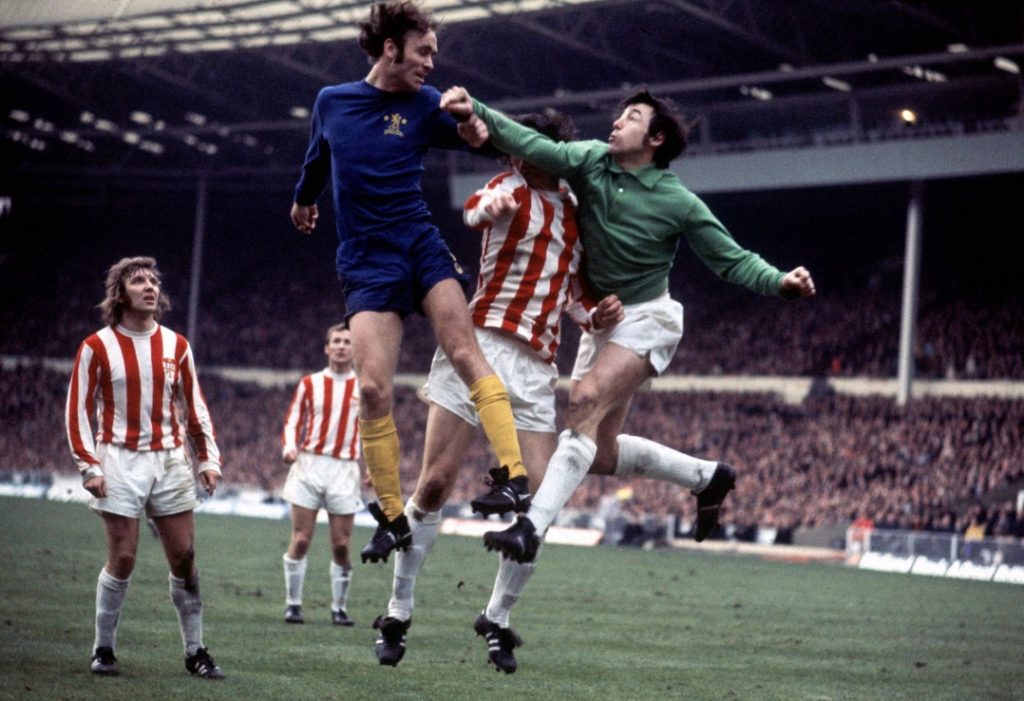
Gordan Banks is considered one of the best GKs of all time. He was the keeper for England when it won its only World Cup championship in 1966 in London. Banks is also famous for a save he made on a header by Brazil’s Pele in the 1970 World Cup. Indeed, Pele and thousands of the fans in the stands in Mexico City had already started to celebrate what seemed to be a sure goal on a strong header from Pele. However, Banks in an instant dove and dug the ball up and over the crossbar in one amazingly quick and skillful move. Many players, GKs, and fans still consider Bank’s stop of Pele’s header to be the greatest save ever. (Video of Banks’ famous save of Pele’s header.) In 1973 and still playing at the top of his game, Banks was seriously injured in a car accident. As a result, he tragically lost vision in his right eye, and retired from top-flight football in England. However, three years later in 1976 he took the pitch again and played in goal for the Fort Lauderdale Strikers team, part of the USA’s then recently founded professional North American Soccer League (NASL). In the first of two seasons with the NASL’s Fort Lauderdale team, Banks did much to help spread the game of soccer in America, helped his team win their division, and was awarded the NASL’s goalkeeper of the year award.

Liverpool FC’s Ray Clemence, who as a professional played in goal for a total of 33 years, helped his world-renowned “big club” Liverpool team win numerous U.K. and international titles. He is widely considered to be the best GK to ever play for the famous Liverpool Football Club, and the English Magazine “Total Football” once published a poll that ranked Clemence as the game’s best goalkeeper, period.

Dino Zoff is one of the best Italian keepers of all time. When he was fourteen several professional clubs told him he was too small to be a goalkeeper. But Zoff persisted at the GK position, grew to be six feet tall, and was signed at 19 to a professional contract. He went on to play professionally for another twenty-four years, only retiring when he was 43. At 40 years old, he became the oldest starting GK to play on a team that won the World Cup.

Packie Bonner, nicknamed “the big man from Donegal” Ireland, played professionally for Scotland’s Celtic Football Club, and also starred for the Irish National Soccer team. He helped lead the Irish to their best-ever World Cup finish, i.e., a quarter-final appearance in the 1990 World Cup. After Bonner’s famous save on a penalty kick to put Ireland through to the quarterfinals, Packie and his teammates were invited to meet with Pope John Paul II in Rome, where the World Cup was being hosted. And as the Irish team assembled in the Vatican, the Pope asked, “which one of you is the goalkeeper?” Packie raised his hand, and the Pope said to him, “I’ll be keeping a special eye out for you, because when I was a young boy living in Poland I too was a goalkeeper.” Unfortunately for Ireland and Bonner, despite the Pope’s attention, the Irish lost the next game to host nation Italy’s team, with Packie letting up the only goal in the 1-0 defeat.
Tony Meola was one of the first American goalkeeper to earn a worldwide reputation. Tony grew up playing soccer in New Jersey, and then played GK at the University of Virginia, where he and the Cavaliers team won the NCAA’s 1989 soccer national champioinship. Meola then turned pro, and he was in goal in also 1989 for the U.S. national team’s must-win victory versus Trinadad and Tobago, i.e., a win that qualified for the American team for its first World Cup in 40 years, thanks to a long U.S. shot on goal that found the net, which came to be know as “the shot heard around the world.”
Tim Howard was one of the first American goalkeepers to play for one of the very biggest “big clubs” in the world. After growing up in New Jersey, Tim became a pro when he was just 18 and still in high school. After a few more years playing in the U.S. as a GK on Major League Soccer’s NY/NJ MetroStars team, in 2003 at age 24 he was purchased by one of the most famous, most successful, and best teams in the world of soccer – the legendary Manchester United Football Club. While playing for Man U from 2003 through 2005, Howard became only the second American to ever win England’s prestigious Football Association (FA) Cup championship, and the first American to do so since way back in 1873. Howard later went on to also star with England’s strong, top-level Everton team, as well as play as the U.S. national team’s top GK in 121 international matches, the most ever for a U.S. goalkeeper.
So indeed green is the jersey that is rightly claimed by those unique, few soccer players who members of the “Goalkeepers Union” are at the are the heart and soul of the game. These GK Union men and women put on the gloves, take up their place on the pitch between the posts and beneath the crossbar, and make the victory saving, awe-inspiring stops that are such a big part of playing and watching the beautiful game.
Even more meaningfully, these great GKs personalities demonstrate what it means to strive to meet what are nearly impossible challenges, and yet to indeed frequently amazing, successfully achieve and meet such challenges – that is, in a game designed for and dedicated to scoring goals, in numerous games GKs, with their teammates, against all odds succeed in preventing any goals at all. Reflecting on such success despite the formidable challenges, and as suggested by the preceding accounts of great goal keepers, as Jonathon Wilson, in his book The Outsider: A History of the Goalkeeper, observed: “No sportsman, surely, so regularly confronts the arbitrariness of the fates as the goalkeeper.” And along the same lines, but in a yet universal, sweeping vein, Albert Camus – the renowned author, philosopher, and a promising, fervent, and courageous goalkeeper for his university, whose soccer playing days were sadly cut short by contacting then incurable tuberculosis – proclaimed:

The Perpetual, Growing Green of Mack Brady’s Penn State Soccer Dream
Penn State’s famed Jeffery Field is where the Nittany Lion varsity soccer games are played. That pitch, along with its adjacent soccer training grounds, are known as some the very best U.S. soccer fields, and indeed some of the best anywhere, for playing, practicing, and training. Here is a 2011 video on some of the continuous planning and constant work that goes into ensuring Jeffery is at all times a first-class, top-of-the-line soccer game playing and practice facility. As captured below, Jeffrey Field is a brilliant pitch and soccer complex, with several lush fields of full nourish, and allow to flourish, endless, deep green, and growing soccer / GK dreams.
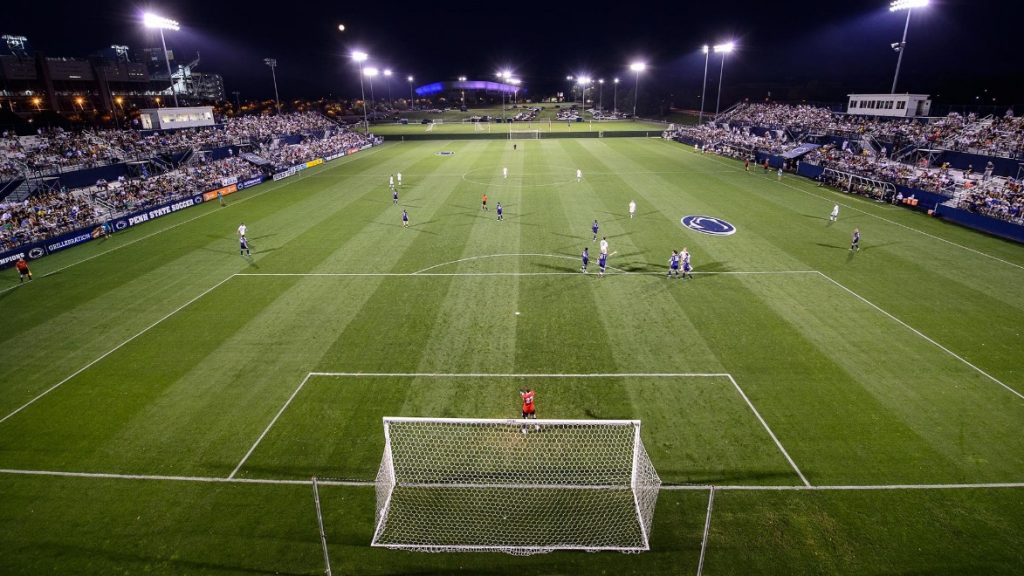
As a young GK and Penn soccer fan, Mack Brady (whose father Christian was Dean of Penn State Schreyer Honors College from 2006 through 2016, and whose mother Elizabeth is an Teaching Professor of Communication Arts and Sciences at Penn State) often frequented Jeffery Field as his go-to place. Jeffrey Field was a soccer mecca where Mack and his young soccer buddies would frequently gather to watch the tough Big Ten battles that were underway. Mack attended many Penn State soccer games, and there would carefully observe the play of the Nittany Lion goalkeepers. He would get as close as he could to the field and the GKs to listen, watch and study the keepers as they directed the Nittany Lions’ defense. At Jeffery he also saw how the GK, or the defenders, once Penn State had earned possession of the ball, then quickly launched the team’s offense and its swift, powerful counter-attacks. Mack internalized what he observed the Penn State GKs and teammates doing. He grasped how GKs played a key role in leading their team. And after watching yet another game, Mack would again tell his family that in the future it would be him in between the pipes, that someday soon he would be bravely defending the Nittany Lion’s goal against all action that came his way.
Mack also carried those lessons he learned from Jeffery to the soccer fields that he practiced and played on as an outstanding member of the fine, young State College Celtics’ club soccer team. Mack soon became the go-to keeper for his squad, which is of course what he wanted, and what he worked hard to earn. And those who saw him in goal said he was one of the best young GK playing the game in central PA.
Mack also learned more from watching his GK heroes, including the Spanish GK superstar and 2010 World Cup winner Ikar Cassilla. Ikar is pictured below, also in green, shown diving fearlessly and at full-stretch to make an amazing save. Mack had a replica of Cassillas’ full uniform and often wore it proudly.

Mack’s favorite U.S. team was DC United, And speaking of young GKs like Mack who showed promise far beyond their years, DC United’s long-serving, outstanding GK Bill Hamid — below and again entirely one with the theme of GKs wearing green — remains the youngest GK to ever win a MLS game, at just 19 years old. And below right next to Bill is a photo of Mack with his beloved DC United gear on display, is Mack smiling with his biggest, budd and fan, Mack’s soccer-supporting dad. And another one of Mack’s favorite overseas teams was Celtic FC in Scotland, as Mack’s State College boys team was named after the famous Celtic Football Club. Another photo below is Mack, again with his beaming smile and sporting his State College Celtics GK jersey, with his Mom holding him close, while in her other hand is an official Celtic FC ball.

Bill Hamid 

And Mack took the hard work, passion, and beauty he saw while watching great soccer and goalkeeping at Penn State in pro soccer games, and in turn started to make some of his own soccer magic when he hit the field. In the shot below taken by Mack’s father Chris, Mack is playing in one of his first games ever for the State College Celtics. The contest pictured was a three-on-three game, and Mack spent a good bit of the game in the back defending his goal, as those with natural GK inclinations and aspirations are apt to do even when playing in small-sided, no GK games. Yet here we see that Mack knew not just how to make saves and stop goals. He also was super natural at shooting and scoring. As seen in this shot, Mack is wearing his green jersey with his favorite #7 on his back. And Mack is on the move — he’s in the clear, and the photo caught him as he is just about to drill the ball into the goal. Great GKs need to be quite skillful with their feet as well as their hands, and should know also what it requires and feels like to score goals. Such experience at the other end of the field helps GKs to strive to defend and save — instead of score — goals as well. (Video of Mack scoring in the first ever SC Celtic 3v3 tournament.)
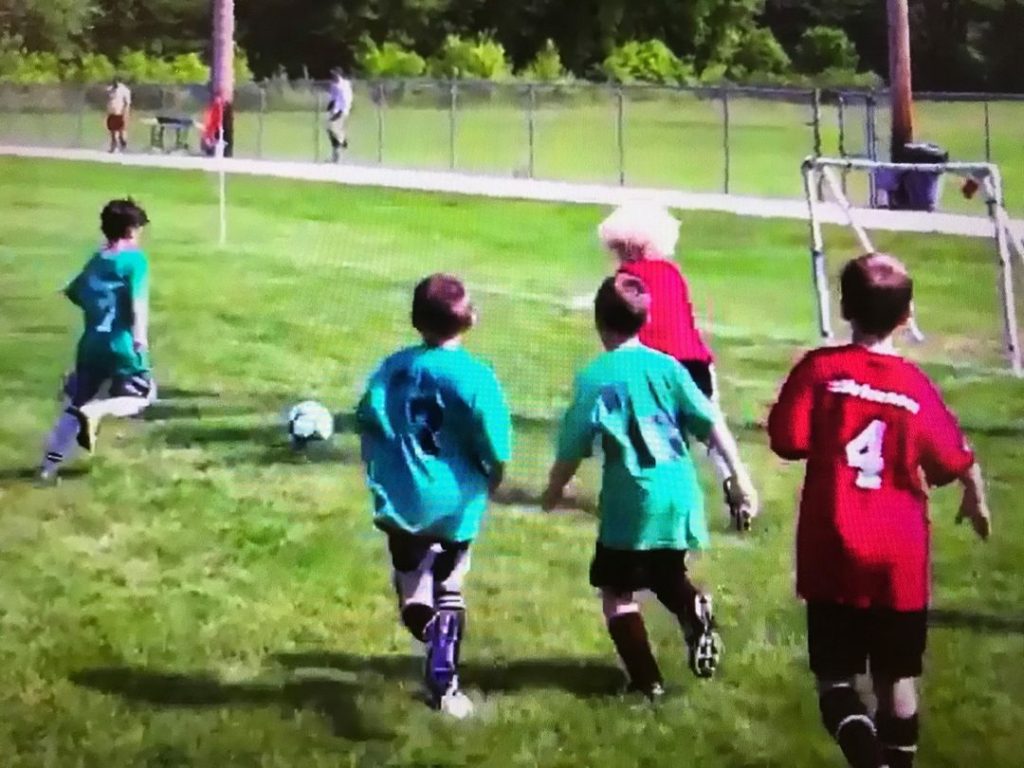
As mentioned, while Mack was for some time a full-field soccer player, he soon gravatated to being mostly a full-time GK. Here is a photo of Mack holding down the goal with some help from his teammates, who were moving forward with confidence knowing that Mack had their back, and was ready at all times to help keep the ball out of the net. In this photo – a shot Mack’s Dad took and titled “The Great Defenders” — even as a young GK, Mack’s focus and commitment to being the team’s #1 GK and leading the defense is clear to see.
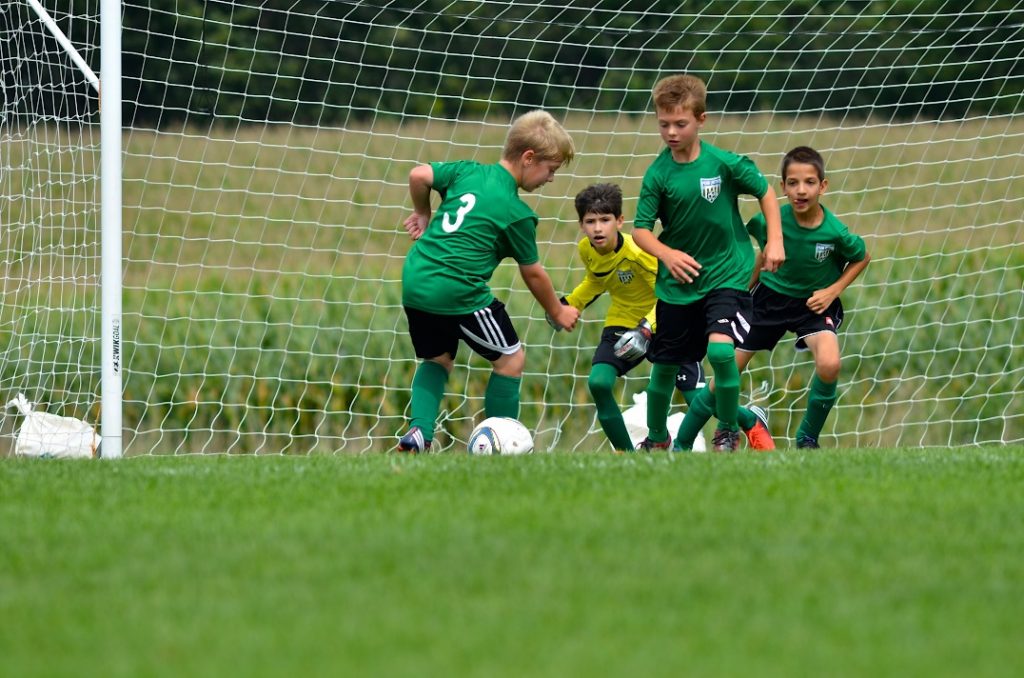
And while I never met Mack, nor saw him play in person, I did see, obviously, many photos an well as film of him playing. And as someone who considers himself still to be a GK despite now being significantly slowed down by being a bit over sixty years old, I still feel like I know something about Mack, and how as a young boy he lived and dreamed of being a great GK. Along these lines, in the photo below, Mack is standing directly behind one of the goals at Penn State’s Jeffery Field. While I don’t recall this clearly, I do believe and hope that I did see Mack standing behind the goal at several Penn State games, as that is where young and old GKs alike gather to be as close as we could to watch the player doing the GK job we loved.

And I remember being a young boy and dreaming of making the big save to keep my team in the lead in and lock down the victory for my teammates, and then feeling all the more a legit GK when those dreams did indeed come true in some of my games. And even when they didn’t always come true, I knew I would get back up, learn some lessons, and get back to work. I learned to love being the last man avialable to stop the shot. And along with making those saves, I learned to love the sharp sensations that went along with stopping these shots: the sweet sting as my hands (not too many GK gloves in my youth playing days) blocked a ball bound for the goal, or the thump of a blast that bounched off my chest, arms or legs, or even the ball that crashed into my face – any and all of me, including my spirit, heart, and soul were all commited to doing whatever it took to keep the ball out of the net. As GKs were ready, willing, and able in any instant to throw caution, and even frankly a good of our sanity, to the wind, throwing ourselves high into the air to make as save, only to of course then come down to hit the hard ground, and doing this over and over again. But what matter if we made the save? We lived to throw our bodies into harms way to thwart charging strikers about to stike, as captured in one photo of Mack making a diving save below, and in the other photo of my own son Danny playing GK for Penn State vs the U.S. Naval Academy. Captured here where instances when both Mack and Danny dived and sacrificed to successfully stop what would have been sure goals.
This photo of my son was taken by Chris Brady, Mack’s Dad, only a few years after Mack had passed away, with Danny defending the goal Mack had stood behind in the photo above only a two short seasons prior. My son played GK on the Nittany Lions team for five seasons, and always wore the number 27, and wore Mack #7 patch on his back for three of those five fall seasons. And once I learned of Mack’s story, it always seemed to me that Danny’s #27 jersey stood for Penn State having two number 7s on the team – Mack and Danny.
The photos below captures a few other mememtos and GK gear that serve to help keep Mack’s GK legacy alive with the Penn State men’s soccer program, including a photo of Mack’s own green jersey that he wore for the State College Celtics; the Mack patch that Penn State GKs wore for years on the back of their jerseys, i.e., the patch that also spurried a slogan for Nittany Lion keepers: “Mack has our back;” and customized Mack Brady GK gloves that have had Mack’s name and number literally helping former PSU GKs to continue to learn the goalkeeping trade and make great saves.
And speaking of Mack’s legacy continuing to have a real impact on Penn State soccer, every year since Mack passed away, the Penn State men’s team has dedicated one game a season – the annual “Mack Brady Match” — to Mack and his memory. And with Mack’s inpiration, Penn State has a overwhelmingly winning record in Mack’s annual match, with five victories, two ties, and just one loss over the first eight years of Mack’s annual memorial game. Here is a photo of the Brady family in the stands at Jeffrey Field at the recent 2021 Mack Match, which resulted in a 1-0 Penn State clean-sheet/shut-out win over Ohio State.

Other Mack memorial events included a 2016 game where Mack was honored by the Philadelphia Union MLS team. The photo below shows the Union’s PPL Park’s scoreboard featuring the Mack Brady Memorial Men’s Soccer Fund, which supports the Penn State soccer team, and specifically PSU’s goalkeepers. Since the funds creation, over $270,000 has been contributed in Mack’s memory, and these funds have helped to strengthen the men’s soccer programs – especially PSU’s “Goalkeeper U.” Also pictured below are Mack’s Dad Christian, Mack’s Mom Elizabeth, and Mack’s Sister Izzy meeting the Union’s then goalkeeper coach Paulo Grilo on the field before the 2016 Philly Union game.
In addition, each year the Penn State men’s soccer team hosts the Mack Brady Memorial Soccer Clinic, where young soccer players gather in Penn State’s Holuba Hall, an indoor football/soccer field, for a soccer clinic presented by Penn State soccer players and coaches. Hundreds of young soccer players, including many of Mack’s origional State College Celtic teammates, have attended Mack’s Clinic over the 9 years it has been held. Below is a photo of two Penn State GKs, both with Mack’s patch on their backs, with some of the youngsters attending Mack’s Clinic.
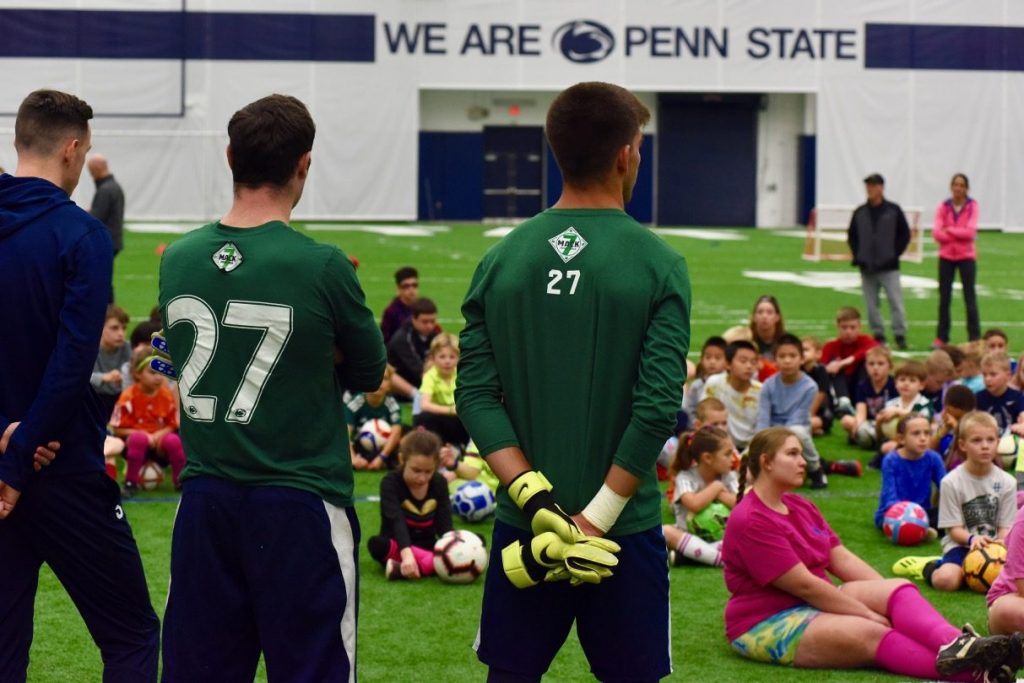
For Mack’s 2021 Clinic, it was not possible to host the session in person due to the COVID pandemic. However, instead a inspiring virtual / online clinic was held, and it included an amazing lineup of former Penn State goalkeepers, as well as several outstanding professional goalkeepers, a former famous MLS head coach, Ben Olson from DC United, and two pro GK coaches also. Pictured below are the past and present professional goalkeepers who participated in Mack’s virtual clinic, including proud PSU grad and pro soccer star Amanda Dennis, now playing professionally for the Houston Dash of the National Women’s Soccer League; recently retired GK Luis Robles who played for and resently retired from the MLS’s Inter Miami team, and who earned the the 2015 MLS goalkeeper of the year award; and Nick Rimando, who retired from the MLS and the Real Salt Lake team after setting nearly every major GK record for the league, including playing in the most games as a GK (424), most wins by a GK, and most shutouts (129). The recording of Mack’s Virtual Clinic is online here.
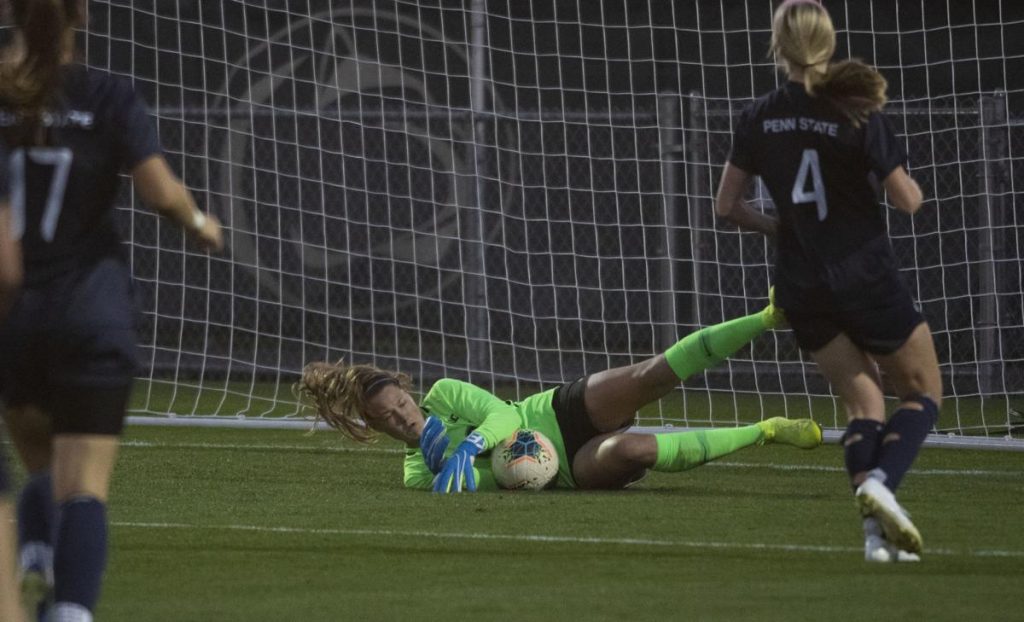
Amanda Dennis 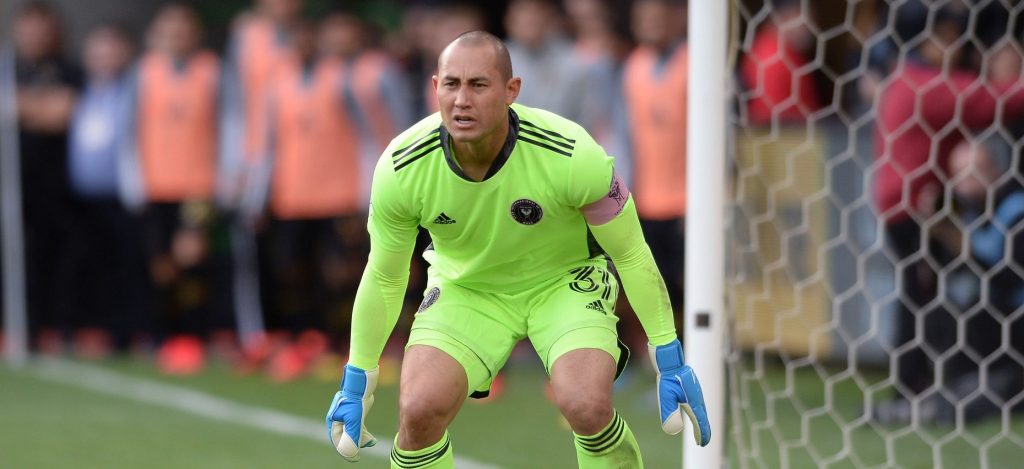
Luis Robles 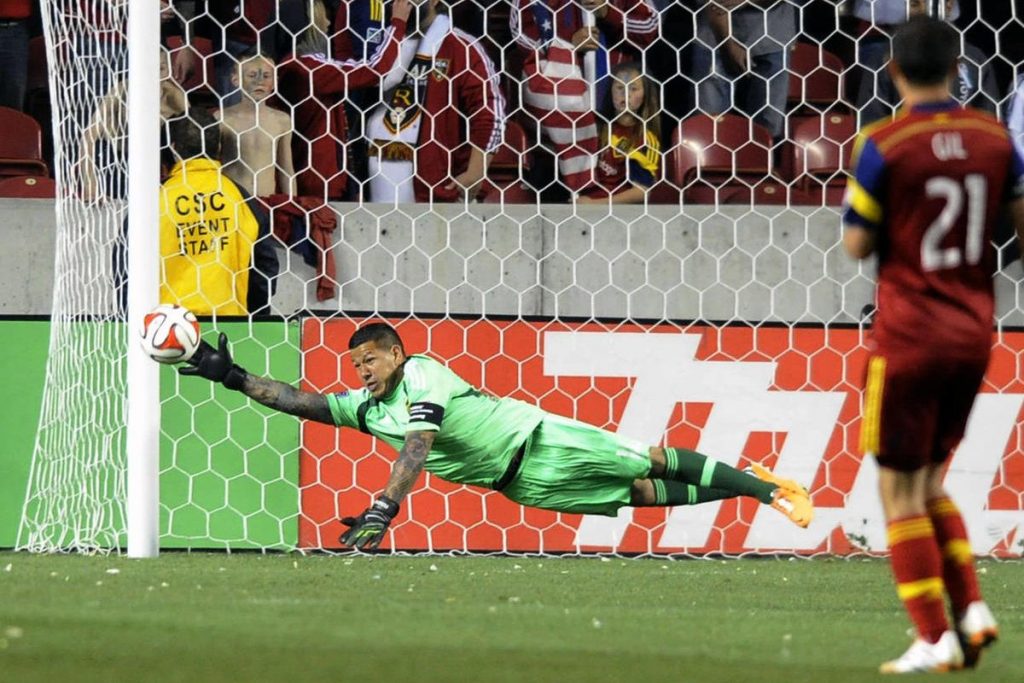
Nick Rimando
All around the world and over many decades international goalkeepers, and Penn State GKs too, have been proud to pull on green jerseys and then defend their goals with everything they had. Further, for nine years now more recent Penn State’s GKs have been proud to wear some sort of green GK jersey, similar to the ones Mack Brady wore playing for his State College Celtics team. Thus, Penn State GKs and soccer teams are maintaining a great green goalkeeper tradition, while as well honoring Mack Brady – himself a great fellow goalkeeper and a true Penn State teammate. Mack loved being a GK, loved the Nittany Lions, and loved his GK brothers who patrolled Penn State’s goals. These are young men who, like Mack did, now give all they can to prevent any shot from ever crossing their goal line. And as the photos below of two current PSU keepers show, Mack’s legacy continues to make and maintain PSU the home of GKU — Goalkeeper University. The Brady GK program will continue to motivate and inspire each new Nittany Lion GK, and every Penn State white, blue, and green-wearing soccer team. And Mack’s legacy will continue to grow as part of the great Penn State soccer and goal keeper way, at Jeffery Field and wherever Penn State GKs play.
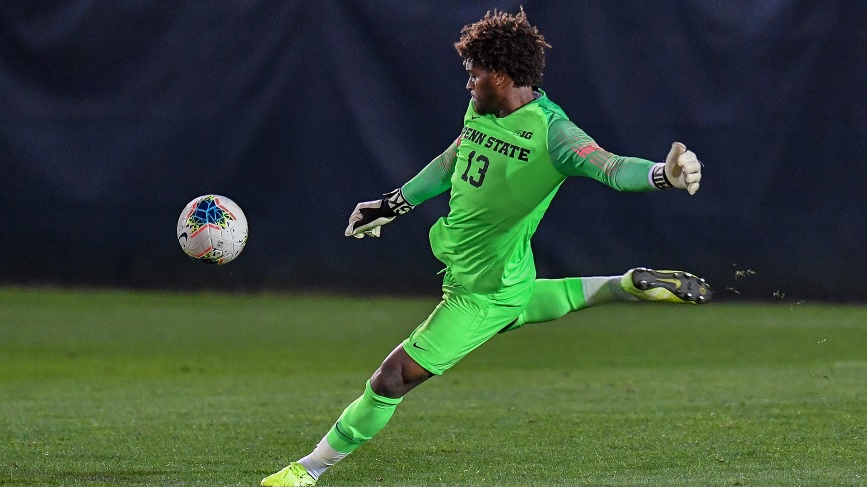
Kris Shakes 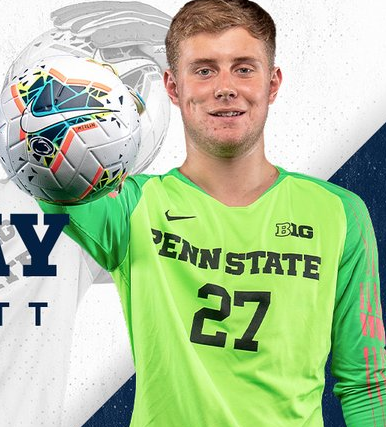
Owen Elliot
Or Walt Whitman, in his renowned book of poems titled Leaves of Grass, once wrote – and here the famous bard perhaps prophetically envisioning something along the lines of the photo below taken just after the first-ever Mack Brady Match:
“ … A child said, What is the grass? fetching it to me with full hands …
I guess it must be the flag of my disposition, out of hopeful
green stuff woven.
Or I guess it is the handkerchief of the Lord,
A scented gift and remembrancer designedly dropped,
Bearing the owner’s name someway in the corners, that we
may see and remark, and say Whose? … “
Whose indeed? At Penn State’s Jeffrey Field, there in front of the goals, that patch of green stuff woven is perpetually Mack’s, and the patch is owned by Mack’s PSU GKU brothers too — all of them forever bravely standing together, there in back.
